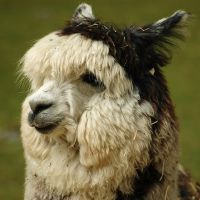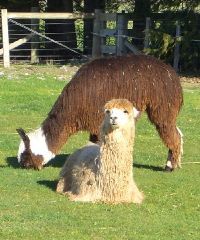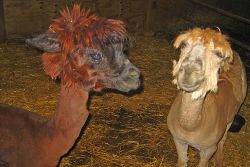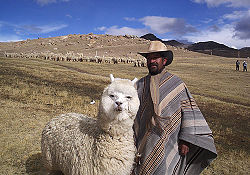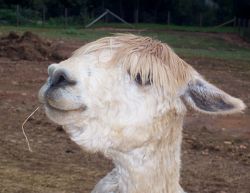Alpaca
| Alpaca | ||||||||||||||
|---|---|---|---|---|---|---|---|---|---|---|---|---|---|---|
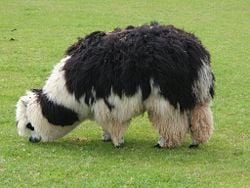 An unshorn alpaca grazing
| ||||||||||||||
|
Domesticated
| ||||||||||||||
| Scientific classification | ||||||||||||||
| ||||||||||||||
| Vicugna pacos (Linnaeus, 1758) | ||||||||||||||
 Alpaca range
|
Alpaca is the common name for a domesticated, gregarious, high-altitude South American ungulate, Vicugna pacos (syn. Lama pacos), of the camel family (Camelidae), characterized by a very long neck, long and slender legs (but short relative to the similarly appearing llama), small and elongate head, short ears with thin points, short tail, and a cleft upper lip. While its native range is in the high Andes mountains, this large herbivorous mammal is no longer found in the wild, but is maintained extensively in domestic herds, largely grazing in high elevations of the Andes of Peru, Bolivia, Ecuador, and Chile; the alpaca is commercially raised as well on other continents, notably in North America and Australia.
Alpacas are not used as beasts of burden, but mainly are valued for their fiber, and traditionally have been valued also for meat, hair, hides, and their dung, used as fuel. They have been domesticated for thousands of years, even prior to the Incas, who raised and bred alpacas for textiles reserved for royalty.
Alpaca fiber is lustrous, soft, and silky, and provided in enough quantity for commercial use. Alpaca wool is used for making knitted and woven items, much as with sheep's wool. These items include blankets, sweaters, hats, gloves, scarves, a wide variety of textiles and ponchos in South America, and sweaters, socks, coats and bedding in other parts of the world.
Overview and description
Alpacas are even-toed ungulates (order Artiodactyla), with two-toes on each foot and an "unguligrade" form of locomotion. (Unguligrade involves most of the weight of the animal supported by the hoofs, in contrast with "digitigrade," where the toes touch the ground, or "plantigrade," where the entire foot is on the ground, as in humans.) There are three other camelids in South America, the domesticated llama (Lama glama), and the wild guanaco (Lama guanicoe) and vicuña (Vicugna vicugna). The alpaca was traditionally placed in the Lama genus (Lama pacos) with the llama, but generally is now placed with the vicuña in genus Vicugna.
The alpaca and llama are only known in the domestic state. While visually similar, alpacas are considerably smaller than llamas and the alpaca has a shorter head than the llama. Llamas, which are the largest South American camelid, are on average 1 to 2 feet taller and proportionally bigger than alpacas. Alpacas and llamas also differ in that alpacas have straight ears and llamas have banana-shaped ears (rather long and slightly curved inward) and llamas do not have eyelashes, while the alpaca does.
Alpacas have a camel-like face, a long neck, ears that have thin points, and an upper lip with a deep cleft. The tail is short. There is no dorsal hump as in the camels. With the exception of the face and legs, the entire body is covered with a long, thick, and soft wool, and the hair can stand on the head, presenting a tuft that can cover the eyes in males. The alpaca is larger than the vicuña but smaller than the other camelid species. The adult alpaca reaches about 90 centimeters (3 feet) in height and 70 kilograms (154 pounds) in weight (Grzimek et al. 2004).
Alpacas are kept in herds that graze on the level heights of the Andes of Ecuador, southern Peru, northern Bolivia, and northern Chile at an altitude of 3000 to 4800 meters (9,800-15,750 feet) above sea-level, throughout the year (Grzimek et al. 2004).
As with all the South American camelids, alpacas digest their food by the process of rumination. Their stomachs are divided into three chambers (Nowak 1983). After food is swallowed, it is kept in the first chamber for a while where it is partly digested with the help of bacteria and protists.
Alpacas and llamas can (and do) successfully cross-breed. The resulting offspring are called huarizo, which are valued for their unique fleece and often have gentle temperaments and are suitable for pets.
History of the scientific name
In the eighteenth and nineteen centuries, the four South American camelid species were assigned scientific names. At that time, the alpaca was assumed to be descended from the llama, ignoring similarities in size, fleece, and dentition between the alpaca and the vicuña. Classification was complicated by the fact that all four species of South American camelid can interbreed and produce fertile offspring. It was not until the advent of DNA technology that a more accurate classification was possible.
In 2001, the alpaca genus classification changed from Lama pacos to Vicugna pacos in many taxonomies following the presentation of a paper (Wheeler et al. 2001) on alpaca DNA to the Royal Society showing that the alpaca is descended from the vicuña, not the guanaco. The relationship between alpacas and vicuñas was disputed for many years, but Wheeler's DNA work provided substantial evidence of the relationship. However, many academic websites have not caught up with or embraced this change.
Behavior
Alpacas are social herd animals that live in family groups consisting of a territorial alpha male, females, and their young. They are generally considered gentle, inquisitive, intelligent, and observant. As a prey animal, they are cautious and warn the herd about intruders by making sharp, noisy inhalations that sound like a high pitch burro bray. The herd may attack smaller predators with their front feet, and can spit and kick. Due to the soft pads on their feet, the impact of a kick is not as dangerous as that of a hoofed animal, yet it still can give quite a bruise, and the pointed nails can inflict cuts.
Alpacas have a communal dung pile, where they do not graze. This helps in the control of internal parasites. Generally, males have much tidier, and fewer dung piles than females who tend to stand in a line and all go at once. One female approaches the dung pile and begins to urinate and/or defecate, and the rest of the herd often follows.
Spitting
Not all alpacas spit, but all are capable of doing so. "Spit" is somewhat euphemistic; occasionally, the projectile contains only air and a little saliva but alpacas commonly bring up acidic stomach contents (generally a green grassy mix) and project it onto their chosen target. Spitting is mostly reserved for other alpacas, but an alpaca will occasionally spit at humans that, for example, take away food.
For alpacas, spitting results in what is called "sour mouth." Sour mouth is characterized by a loose-hanging lower lip and a gaping mouth. This is caused by the stomach acids and unpleasant taste of the contents as they pass out of the mouth.
Some alpacas will spit when looked at, others will never spitâtheir personalities are very individualized and there is no hard and fast rule in terms of social behavior, although there is often a group leader, and a group trailer/runt that is picked on by others.
Sounds
Individuals vary, but alpacas generally make a humming sound. Hums are often comfort noises, letting the other alpacas know they are present and content. The humming can take on many inflections and meanings, from questioning to a high-pitched, seemingly almost desperate, squealing when a mother is separated from her offspring.
Alpacas make a variety of sounds. When they are in danger, they make a high-pitched, shrieking whine. Some breeds are known to make a "wark" noise when excited. Strange dogsâand even catsâcan trigger this reaction. To signal friendly and/or submissive behavior, alpacas "cluck," or "click" a sound possibly generated by suction on the soft palate, or possibly in the nasal cavity. This is often accompanied by a flipping up of the tail over the back.
When males fight they also scream, a warbling bird-like cry, presumably intended to terrify the opponent. Fighting determines dominance, and therefore the right to mate the females in the herd, and it is triggered by testosterone. This is why males are often kept in separate paddocksâwhen two dominant males get together, violent fights often occur. When males must be pastured together, it is wise to trim down the large fang-like teeth used in fights, called "fighting teeth." Although alpacas may try to bite each other, they only have a bottom row of teeth, so damage is usually minimal. When fighting they will often tangle others necks and attempt to push each other around, but they settle down after a week, as they establish dominance.
When alpacas breed, males make a similar noise called an "orgle." This is thought to possibly stimulate ovulation in the female. This can sound like a warbling or gargling noise in the back or the throat, possibly generated by movement of the tongue.
Reproduction
Females are "induced ovulators," which means that the act of mating and the presence of semen causes them to ovulate. Occasionally, females conceive after just one breeding (which can last anywhere from 5 minutes to well over an hour) but occasionally do have troubles conceiving. Artificial insemination is technically difficult because the act of breeding stimulates ovulationâbut it can be accomplished. Babies conceived from artificial insemination are not registerable with the Alpaca Registry.
A male is usually ready to mate for the first time between one and three years of age. A female alpaca may fully mature (physically and mentally) between 12 and 24 months. It is not advisable to allow a young female to be bred until she is mature, as over breeding a young female before conception is possible is a common cause of uterine infections. As the age of maturation varies greatly between individuals, it is usually recommended that novice breeders wait until females are 18 months of age or older before initiating breeding.
The young male's penis is attached to the prepuce, and generally does not detach until one to two years of age. The penis is a very long, thin, prehensile organ that is perfectly adapted for the task of finding the vaginal opening despite a fluffy tail, penetrating the hymen (if present,) navigating the vaginal canal, and entering the cervical opening, where deposit of the semen occurs.
Pregnancies last 11.5 months ± 2 weeks, and usually result in a single offspring or cria. Twins are rare, approximately 1/1000, slightly rarer than the proportion of twins in human births. After a female gives birth, she is generally receptive to breeding again after approximately two weeks. Crias may be weaned through human intervention at approximately 6 months and 60 pounds. However, many breeders prefer to allow the female to decide when to wean her offspring. Offspring can be weaned earlier or later depending on their size and emotional maturity.
It is believed that alpacas generally live for up to 20 years and occasionally longer.
History and uses
Alpacas have provided a variety of uses for people, providing wool, meat, hide, and dung, with the later being a valued fuel in areas where there is deficiency of trees to supply wood. These uses even predated the Incas, who bred this species specifically to use its soft fiber for fine textiles (Grzimek et al. 2004).
Alpacas have been domesticated and breed for five thousand years, before the Spanish Conquest and before the Incas (Metcalf 1999). They were central to the Aymara civilization of Western Bolivia before being conquered by the Incas (Metcalf 1999). It is believed that their name came originally from the Aymara language, as pacos, with the name passing to the Incas and the Spanish, and with the prefix al added later (Metcalf 1999).
The Moche people of northern Peru often used Alpaca images in their art (Berrin and Larco 1997). The Moche civilization flourished in Peru from about 100 C.E. to 800 C.E..
Alpacas are too small to be used as pack animals. Instead, they have been bred exclusively for their fiber and meat.
Fiber
Of the various camelid species, the alpaca and vicuña are the most valuable fiber-bearing animals: the alpaca because of the quality and quantity of its fiber, and the vicuña because of the softness, fineness, and quality of its coat.
Alpaca fleece is a lustrous and silky natural fiber. While similar to sheepâs wool in that it is a natural fiber, it is warmer, not prickly, and bears no lanolin, which makes it hypoallergenic (Quiggle 2000; Stoller 2006). It is also soft and luxurious. In physical structure, alpaca fiber is somewhat akin to human hair, being very glossy. The preparing, carding, spinning, weaving, and finishing process of alpaca is very similar to the process used for wool.
The fiber comes in more than 52 natural colors as classified in Peru, 12 as classified in Australia, and 16 as classified in the United States (Horn and Horn).
Meat
Alpaca meat was once considered a delicacy by Andean inhabitants. It remains popular among some South American populations. However, a recent resurgence in the commerce of alpaca meat was curtailed by a recent change to Peruvian law granting the alpaca protected status. Today, it is illegal to slaughter or trade in alpaca meat in Peru. Because of the high price commanded by alpaca on the growing North American alpaca market, illegal Alpaca smuggling has become a growing problem (Hennessy 2005).
ReferencesISBN links support NWE through referral fees
This article originally incorporated text from the EncyclopĂŠdia Britannica, Eleventh Edition, a publication now in the public domain.
- Berrin, K. and Larco Museum. 1997. The Spirit of Ancient Peru: Treasures from the Museo ArqueolĂłgico Rafael Larco Herrera. New York: Thames and Hudson. ISBN 0500018022.
- Grzimek, B., D. G. Kleiman, V. Geist, and M. C. McDade. 2004. Grzimek's Animal Life Encyclopedia. Detroit: Thomson-Gale. ISBN 0307394913.
- Hennessy, H. 2005. Microchips to guard Peruvian alpacas. BBC News March 30, 2005. Retrieved November 21, 2008.
- Horn, P., and R. Horn. n.d. Alpaca colors. All American Alpacas.
- Metcalf, A. A. 1999. The World in so Many Words: A Country-by-Country Tour of Words That Have Shaped our Language. Boston: Houghton Mifflin. ISBN 0395959209.
- Nowak, R. M., and J. L. Paradiso. 1983. Walker's Mammals of the World. Baltimore: Johns Hopkins University Press. ISBN 0801825253.
- Quiggle, C. 2000. Alpaca: An ancient luxury. Interweave Knits (Fall 2000): 74-76.
- Stoller, D. 2006. Stitch 'N Bitch Crochet. New York: Workman, ISBN 0761139850.
- Wheeler, J., M. Kadwell, M. Fernandez, H. F. Stanley, R. Baldi, R. Rosadio, and M. W. Bruford. 2001. Genetic analysis reveals the wild ancestors of the llama and the alpaca. Proceedings of the Royal Society B: Biological Sciences 268(1485): 2575â2584. Retrieved November 21, 2008.
External links
All links retrieved July 23, 2023.
Credits
New World Encyclopedia writers and editors rewrote and completed the Wikipedia article in accordance with New World Encyclopedia standards. This article abides by terms of the Creative Commons CC-by-sa 3.0 License (CC-by-sa), which may be used and disseminated with proper attribution. Credit is due under the terms of this license that can reference both the New World Encyclopedia contributors and the selfless volunteer contributors of the Wikimedia Foundation. To cite this article click here for a list of acceptable citing formats.The history of earlier contributions by wikipedians is accessible to researchers here:
The history of this article since it was imported to New World Encyclopedia:
Note: Some restrictions may apply to use of individual images which are separately licensed.
